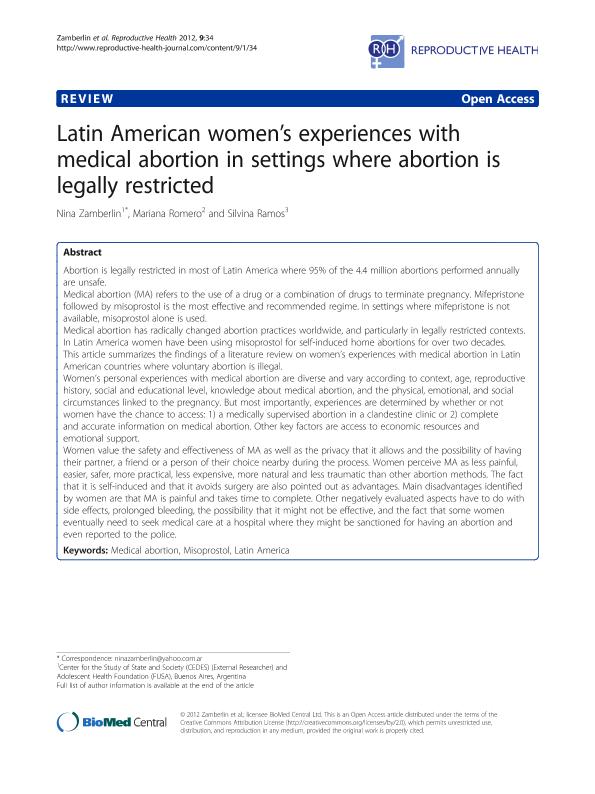Mostrar el registro sencillo del ítem
dc.contributor.author
Zamberlin, Nina

dc.contributor.author
Romero, Mariana

dc.contributor.author
Ramos, Silvina
dc.date.available
2023-06-02T14:01:40Z
dc.date.issued
2012-12
dc.identifier.citation
Zamberlin, Nina; Romero, Mariana; Ramos, Silvina; Latin American women’s experiences with medical abortion in settings where abortion is legally restricted; BioMed Central; Reproductive Health; 9; 1; 12-2012; 1-11
dc.identifier.issn
1742-4755
dc.identifier.uri
http://hdl.handle.net/11336/199360
dc.description.abstract
Abortion is legally restricted in most of Latin America where 95% of the 4.4 million abortions performed annually are unsafe. Medical abortion (MA) refers to the use of a drug or a combination of drugs to terminate pregnancy. Mifepristone followed by misoprostol is the most effective and recommended regime. In settings where mifepristone is not available, misoprostol alone is used.Medical abortion has radically changed abortion practices worldwide, and particularly in legally restricted contexts. In Latin America women have been using misoprostol for self-induced home abortions for over two decades.This article summarizes the findings of a literature review on women's experiences with medical abortion in Latin American countries where voluntary abortion is illegal.Women's personal experiences with medical abortion are diverse and vary according to context, age, reproductive history, social and educational level, knowledge about medical abortion, and the physical, emotional, and social circumstances linked to the pregnancy. But most importantly, experiences are determined by whether or not women have the chance to access: 1) a medically supervised abortion in a clandestine clinic or 2) complete and accurate information on medical abortion. Other key factors are access to economic resources and emotional support.Women value the safety and effectiveness of MA as well as the privacy that it allows and the possibility of having their partner, a friend or a person of their choice nearby during the process. Women perceive MA as less painful, easier, safer, more practical, less expensive, more natural and less traumatic than other abortion methods. The fact that it is self-induced and that it avoids surgery are also pointed out as advantages. Main disadvantages identified by women are that MA is painful and takes time to complete. Other negatively evaluated aspects have to do with side effects, prolonged bleeding, the possibility that it might not be effective, and the fact that some women eventually need to seek medical care at a hospital where they might be sanctioned for having an abortion and even reported to the police.
dc.format
application/pdf
dc.language.iso
eng
dc.publisher
BioMed Central

dc.rights
info:eu-repo/semantics/openAccess
dc.rights.uri
https://creativecommons.org/licenses/by/2.5/ar/
dc.subject
medical abortion
dc.subject
misoprostol
dc.subject
Latin America
dc.subject.classification
Ciencias Sociales Interdisciplinarias

dc.subject.classification
Otras Ciencias Sociales

dc.subject.classification
CIENCIAS SOCIALES

dc.title
Latin American women’s experiences with medical abortion in settings where abortion is legally restricted
dc.type
info:eu-repo/semantics/article
dc.type
info:ar-repo/semantics/artículo
dc.type
info:eu-repo/semantics/publishedVersion
dc.date.updated
2023-05-31T15:08:38Z
dc.journal.volume
9
dc.journal.number
1
dc.journal.pagination
1-11
dc.journal.pais
Reino Unido

dc.journal.ciudad
Londres
dc.description.fil
Fil: Zamberlin, Nina. Centro de Estudios de Estado y Sociedad; Argentina
dc.description.fil
Fil: Romero, Mariana. Centro de Estudios de Estado y Sociedad; Argentina. Consejo Nacional de Investigaciones Científicas y Técnicas; Argentina
dc.description.fil
Fil: Ramos, Silvina. Centro de Estudios de Estado y Sociedad; Argentina
dc.journal.title
Reproductive Health
dc.relation.alternativeid
info:eu-repo/semantics/altIdentifier/url/https://reproductive-health-journal.biomedcentral.com/articles/10.1186/1742-4755-9-34
dc.relation.alternativeid
info:eu-repo/semantics/altIdentifier/doi/http://dx.doi.org/10.1186/1742-4755-9-34
Archivos asociados
